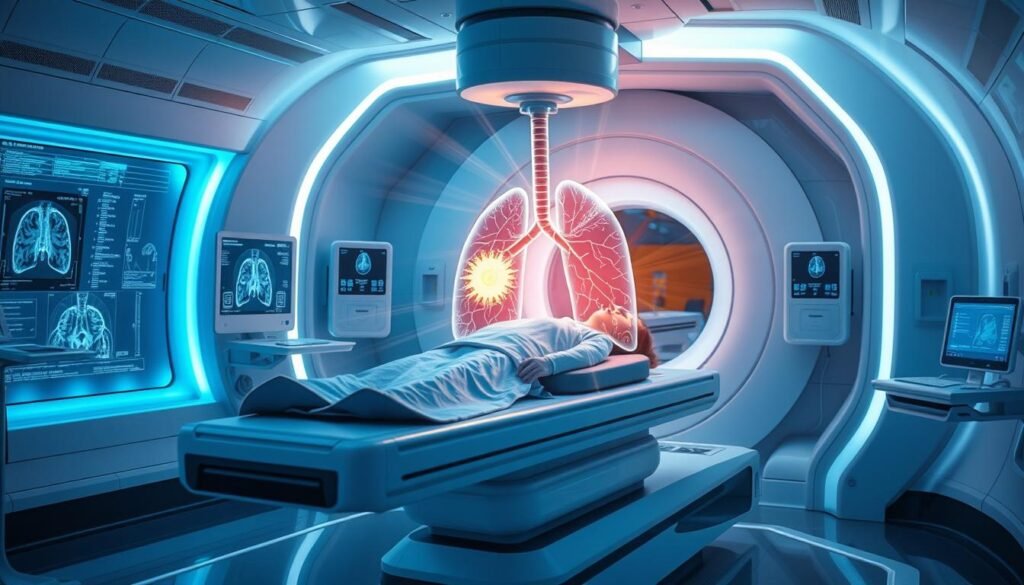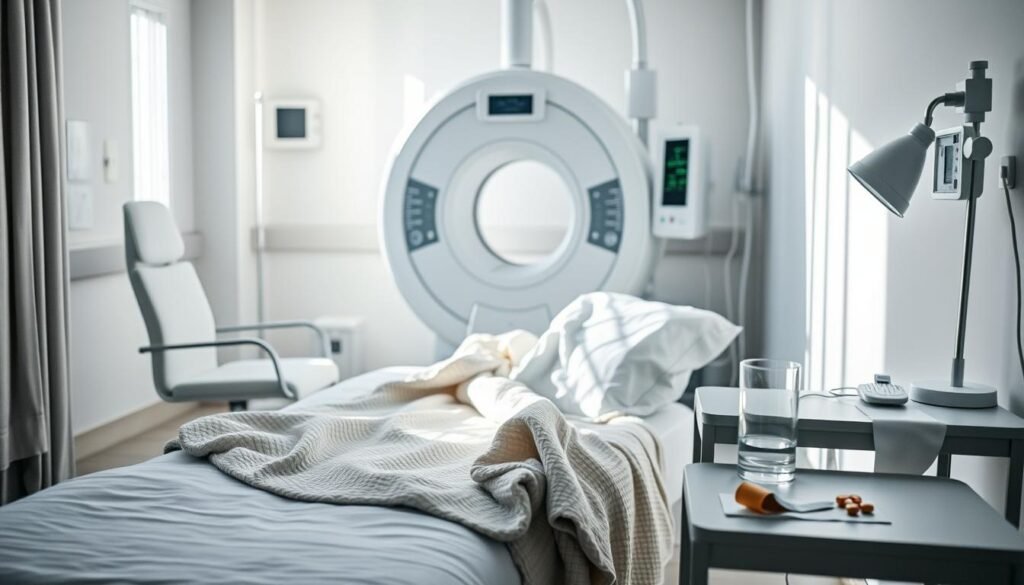Did you know that most lung cancer cases are called non-small cell lung cancers (NSCLCs)? They make up about 80-85% of all lung cancer cases. This fact highlights the need for quick and effective treatments, like the 5 day radiation plan. Quick care is key for those fighting lung cancer. It offers faster relief from symptoms compared to old methods.
Old-fashioned radiation therapy for lung cancer would take five days a week. This would go on for five to seven weeks. But now, there’s a quicker option called short-course radiotherapy. This new method aims to cut down on side effects and speed up recovery time. For example, Stereotactic Body Radiation Therapy (SBRT) can now treat early-stage lung cancer in one to five sessions. This is a big change in how we treat lung cancer.
In this article, we’ll dive into radiation therapy and its types, with a special look at the 5 day radiation treatment. Our goal is to give patients and their loved ones helpful information for this tough journey.
Key Takeaways
- Non-small cell lung cancers (NSCLCs) represent the majority of lung cancer cases.
- 5 day radiation treatment offers a faster alternative to traditional therapy schedules.
- Stereotactic Body Radiation Therapy (SBRT) can provide effective treatment in significantly fewer sessions.
- External Beam Radiation Therapy (EBRT) remains the most common type for lung cancer treatment.
- Advancements in radiation techniques help limit damage to surrounding tissues, enhancing patient outcomes.
Understanding Lung Cancer and Its Stages
Lung cancer includes different lung cancer types, each with its own challenges and treatments. The most common type is non-small cell lung cancer (NSCLC). Knowing the cancer stage is crucial for choosing treatment and predicting outcomes. Early detection is vital. It greatly improves treatment success and survival rates.
Overview of Lung Cancer Types
Lung cancer falls into two main groups: non-small cell and small-cell. NSCLC is often caught early and can be treated with surgery. Small-cell lung cancer is usually found later. It often needs chemotherapy and radiation.
Defining Non-Small Cell Lung Cancer (NSCLC)
NSCLC includes types like adenocarcinoma, squamous cell carcinoma, and large cell carcinoma. Each type demands its own treatment approach. For small, localized tumors, surgery like lobectomy is common. If caught at stage 0, surgery alone might cure NSCLC. This stage has not spread deeper into the lung.
Importance of Early Detection
Early detection benefits all cancer stages. If smokers quit after finding out they have lung cancer, they often do better. Stage II and IIIA NSCLC can be treated with chemotherapy before surgery. This helps improve chances of survival. At stage IV, treatments target specific gene mutations, like KRAS or EGFR.
Early detection is therefore crucial in the fight against lung cancer. It leads to treatments that can extend lives and improve treatment quality. The importance of early detection cannot be overstated. Catching the symptoms early and seeing a doctor can make a huge difference.
What is Radiation Therapy?
Radiation therapy uses high-energy rays or particles to attack cancer cells. It’s especially good for treating lung cancer by shrinking tumors and easing symptoms. Understanding how radiation therapy works helps patients look at their treatment choices.
How Radiation Therapy Works
Radiation therapy’s main job is to mess up the DNA of cancer cells. This stops them from growing. It can be used in different times during treatment: before surgery to make tumors smaller, as the main treatment if surgery isn’t possible, or after surgery to kill any left cancer cells.
Targeting just the tumor, radiation can greatly help patients and lessen the chance of cancer spreading.
Differences Between External and Internal Radiation
There are two key types of radiation therapy for lung cancer: external and internal. External beam therapy uses techniques like 3D-CRT and IMRT. These keep the focus tight on the tumor, saving the healthy tissue around it. SBRT is another approach, giving strong doses in a short time, often just a few weeks.
Internal therapy, or brachytherapy, puts radioactive material close to or inside the tumor. This is a spot treatment. The choice between them depends on tumor size, location, and what the patient prefers. You can learn more about these methods at this helpful resource.
https://www.youtube.com/watch?v=5F-kwsSoypg
| Type of Radiation Therapy | Method | Duration | Benefits |
|---|---|---|---|
| External Beam | 3D-CRT, IMRT, SBRT | Varies (1-7 weeks) | Minimized damage to healthy tissue |
| Internal Radiation | Brachytherapy | Temporary placement | Localized treatment |
5 Day Radiation Treatment for Lung Cancer
Cancer care has advanced a lot, especially with the 5 day radiation treatment. This fast-track method, known as short-course radiotherapy, delivers powerful radiation doses in just a week. It’s a good choice for patients who want to get back to their lives quickly.
Defining the 5-Day Protocol
Patients get radiation therapy every day for 5 days, from Monday to Friday. This quick method is different from the old ways, which took weeks. It helps manage non-small cell lung cancer more efficiently.
Benefits of Short-Course Radiotherapy
Short-course radiotherapy offers many benefits for lung cancer patients:
- Reduced Treatment Time: Finishing therapy in five days helps patients return to normal life faster.
- Lower Side Effect Profiles: It usually causes fewer and milder side effects, making treatment easier to tolerate.
- Improved Patient Compliance: The shorter commitment means more patients finish their treatment on schedule.
Studies show that the 5 day radiation treatment has success rates similar to longer treatments. It’s flexible and works for different lung cancer stages, matching new oncology standards.
| Aspect | Traditional Treatment | 5 Day Radiation Treatment |
|---|---|---|
| Treatment Duration | 3-7 weeks | 5 days |
| Frequency | Daily sessions (Monday – Friday) | Daily sessions (Monday – Friday) |
| Side Effects | Variable severity | Lesser severity |
| Patient Compliance | Moderate | High |
| Survival Rates | Similar outcomes | Similar outcomes |
When is Radiation Treatment Used for Lung Cancer?
Radiation therapy is key to lung cancer treatment. It has different uses based on each patient’s case. Knowing when to use radiation therapy is key to creating an effective plan.
As Primary Treatment Option
For some patients, radiation is the main treatment. This is true especially when surgery isn’t an option. The tumor’s size, location, and the patient’s health play a role in this choice. Radiation aims at the tumor, helping in management and possibly leading to better results.
Post-Surgery Radiation
After surgery, some patients get radiation to kill off any remaining cancer cells. This step helps make the first treatment more effective and reduces cancer coming back. The radiation dose and method is chosen carefully for each person’s recovery.
Palliative Care Considerations
In palliative care, radiation therapy helps reduce symptoms and improve life quality for advanced stage patients. It focuses on easing pain, breathing problems, and other severe symptoms. This helps patients keep a good quality of life during treatment.

Summary Table of Radiation Treatment Uses
| Use Case | Description |
|---|---|
| Primary Treatment Option | Utilized when surgery is not an option, focusing on tumor reduction and management. |
| Post-Surgery Radiation | Aims to eliminate remaining cancer cells after surgery, reducing recurrence risks. |
| Palliative Care Considerations | Designed to alleviate symptoms and enhance quality of life in advanced lung cancer stages. |
Types of Radiation Therapy Techniques
Radiation therapy is a key treatment for cancer, used for over 100 years. It gets better over time. Different therapies are used depending on the lung cancer’s stage. Knowing these methods helps us understand efficient lung cancer treatments.
Stereotactic Body Radiation Therapy (SBRT)
Stereotactic body radiation therapy is advanced. It targets tumors with precision. It gives high radiation doses accurately, protecting healthy tissues. It is especially good for early-stage non-small cell lung cancer patients. It is a top choice among radiation therapies.
Intensity-Modulated Radiation Therapy (IMRT)
Intensity-modulated radiation therapy adjusts radiation doses. It spares healthy tissues while fighting cancer effectively. This approach means the tumor gets the right amount of radiation. Thus, it keeps surrounding organs safe. Fewer side effects from this method lead to a better treatment experience.
Proton Therapy
Proton therapy is a leading-edge technique. It uses protons instead of X-rays. This focuses the radiation, reducing damage to nearby tissues. Its safety and precision offer hope in battling lung cancer. It showcases the latest advancements in the field.
| Radiation Therapy Type | Targeting Precision | Healthy Tissue Sparing | Typical Use Case |
|---|---|---|---|
| Stereotactic Body Radiation Therapy (SBRT) | High | Excellent | Early-stage NSCLC |
| Intensity-Modulated Radiation Therapy (IMRT) | Moderate to High | Good | Various cancer types |
| Proton Therapy | High | Very Good | Complex tumors near critical structures |
To understand more about radiation therapy for lung cancer, it’s vital to check reliable sources. They provide details on the techniques and their use in modern oncology.
How Does Stereotactic Body Radiation Therapy Work?
Stereotactic body radiation therapy (SBRT) is an advanced way to target tumors with high accuracy. It helps protect healthy tissues by focusing high doses of radiation on the tumor. Technologies used in SBRT improve how well it targets tumors and its effectiveness. Before starting, imaging scans give important details about the tumor.
Targeting Tumors with Precision
SBRT uses imaging to know a tumor’s exact location, size, and shape. The treatment uses a linear accelerator (LINAC) for precise radiation. This method is very effective for small tumors, especially those up to 5 centimeters. Setting up SBRT, including getting skin tattoos for marking, takes 2 to 4 hours.
Patients typically need 1 to 5 treatment sessions. Most people can go back to their normal life a day or two after treatment.
Advantages of SBRT Over Traditional Methods
SBRT has clear benefits over older radiation therapies. It requires fewer sessions, usually 3 to 5 over one or two weeks. Traditional therapies often take several weeks. Also, SBRT has higher success rates, between 80 to 90 percent, compared to 30 to 40 percent with older methods.
Patient’s side effects are usually mild, with fatigue being most common. SBRT’s ability to spare healthy tissue while attacking the tumor makes it a modern treatment choice.

Accelerated Radiation Therapy: A Rapid Approach
Accelerated radiation therapy is a big step forward in lung cancer care. It aims to shorten treatment time while making radiation more effective. By increasing the dose but reducing the timeframe, patients see better outcomes.
Understanding Dose Escalation
Increasing the radiation dose to the tumor is key. This method tries to kill more cancer cells while protecting healthy tissue. A study with 300 patients showed that 119 (39.7%) who had accelerated therapy experienced fewer side effects. For example, they had much less skin irritation and nausea compared to standard treatments.
Implications for Patient Outcomes
Accelerated therapy’s impact on patient health is impressive. It doesn’t change survival rates or how well tumors are controlled. But, it does greatly reduce bad reactions. Monitoring things like patient strength and weight loss is also crucial. This ensures each patient’s treatment is tailored to them. Dose escalation proves to be a key way to improve life during therapy.
For more info on how radiation therapy helps fight lung cancer, check out this link.
Common Side Effects of Radiation Therapy
Radiation therapy is key in treating lung cancer. It brings many benefits. Yet, it also leads to various effects during and after treatment. Knowing about these effects helps prepare for what lies ahead.
Physical and Emotional Side Effects
During radiation therapy, patients may have physical side effects such as:
- Fatigue
- Skin irritations
- Difficulty swallowing, often leading to a preference for softer foods like soup and porridge
- Nausea and potential vomiting
- Shortness of breath
These physical impacts can be tough. They may also cause emotional issues like anxiety and depression. It shows the importance of strong support systems for patients.
Managing Side Effects During Treatment
There are ways to lessen both physical and emotional side effects. Some methods include:
- Consuming high-calorie drinks or food supplements to maintain nutrition
- Avoiding spicy and extreme temperature foods to prevent irritation
- Using prescribed medication to alleviate pain and heartburn
- Engaging in relaxation techniques, including mindfulness and visualization to help manage nausea
Talking to your healthcare provider about new symptoms is vital. This includes issues like shortness of breath or ongoing fatigue. Learning how to manage side effects after treatment is key for recovery.

What to Expect During a 5-Day Radiation Treatment Session
Patients getting 5-day radiation treatment will find a program made just for them. They’ll learn how to get ready and what the process involves. They’ll talk with their doctor about treatment choices and look at their health history.
Preparation for Treatment
Before starting the 5-day session, patients take several steps to get the best results. At the first meeting, they discuss treatment paths and possible side effects. Then, a CT scan helps customize the treatment, taking 1-3 hours. Usually, treatment starts 10-14 days after this, giving time for checks and plan adjustments.
The Treatment Process Explained
The treatment itself is straightforward. Patients go to the clinic each day, Monday to Friday, for their radiation. Each session is brief, under 5 minutes, but the whole visit may last 30 to 45 minutes. The team might use special methods, like breath holding, for better precision.
During treatment, patients can listen to their favorite music to feel at ease. It’s important to have follow-up visits 1-3 months later, to check progress and handle side effects. They get info on side effects to be well-prepared. For more on managing side effects, click here.
Conclusion
The 5 day radiation treatment for lung cancer is a key option. It uses new tech and focuses on each patient. This treatment works well for different types of lung cancer. It uses special methods like stereotactic body radiation therapy (SBRT) and intensity-modulated radiation therapy (IMRT). These methods are accurate, which means fewer side effects and better results.
It’s vital to work closely with doctors for good recovery. Today, the five-year survival rate for some lung cancers is 25%. Early and good care can lead to better survival chances. Patients should work with doctors for a care plan that fits their needs.
The way we treat lung cancer is getting better. The 5 day radiation treatment is a powerful way to help patients recover. Knowing about all available treatment options helps people fight lung cancer with confidence.